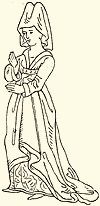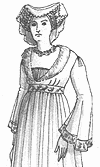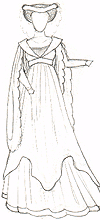
|
Early Tudor Matron from the 15th CenturyNear the end of the Medieval period the waistlines rose and a new kind of surcoat appeared. This more substantial garment had a high waistline, long sleeves, and broad lapels, allowing for more ornamentation near the face. These later styles look more regal, making them a flattering choice for older ladies; more appropriate than the early, clinging styles. Historical InspirationInspired by drawings from A History of Costume by Carl Kohler and Costume 1066-1966 by John Peacock. The following passage from Carl Kohler's A History of Costume also provided inspiration. "About the year 1430 the front and back piece of the bodice were widened, while the formerly large side slits were considerable reduced. In the course of the fifteenth century the neck of the surcot became lower and lower, almost exposing the shoulders. ... It had none of the tightness that had been customary. It came high up on the shoulders, and was cut in a low V-shape in front. The width gradually increased from the bust downward. It was very long in front and at the sides, and had a long train. Close under the breast it was caught up by a wide girdle with a metal buckle. The neck had a turn-over collar, broadest at the back and gradually narrowing toward the front till it met the gridle. ... The sleeves varied in width. Most frequently they were narrow or even tight, but occasionally they were quite wide, sometimes open at the wrist and at other times close-fitting. Some women continued to prefer the sack sleeves."
Pattern HighlightsThe pattern for the overgown's bodice was made from a taping and the skirt is simply a gathered rectangle. The sleaves are two half-circles with a notch cut out of the center of the straight line for the arm hole. The undergown is a simple A-line chemise with six gored panels and long, narrow sleaves. |

Finished Garment 
Inspiration 
Inspiration |
|
|
